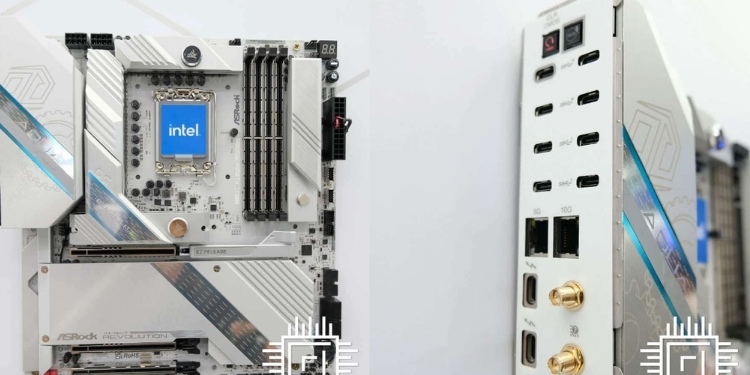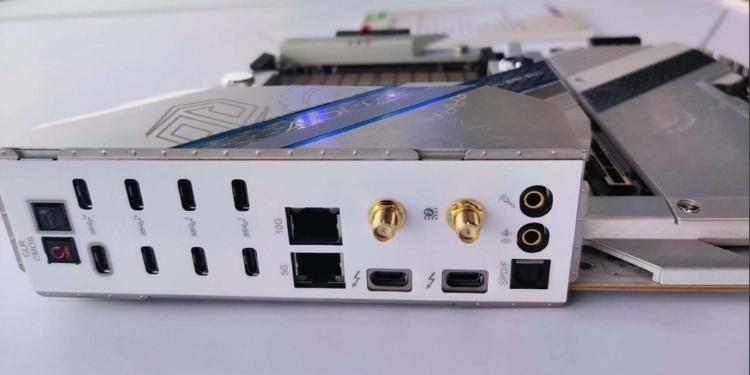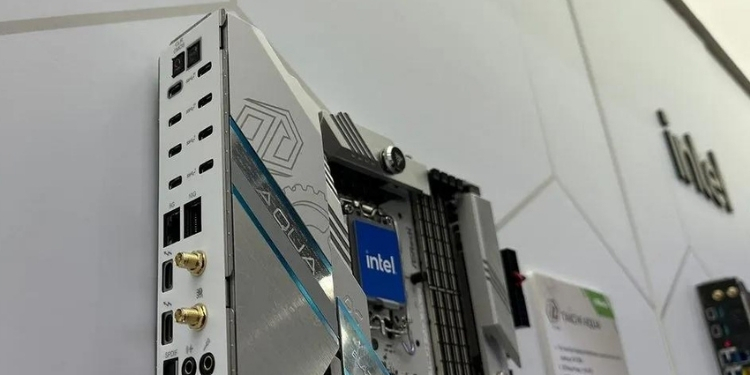Desktop hardware is quickly improving, with each new version offering more power and cool new features. Motherboard manufacturers are consistently pushing boundaries with their flagship models.
At this year’s Computex, ASRock showcased its vision for the next leap – the Z890 Taichi Aqua. ASRock says goodbye to the past and ushers in a Type-C future with this board.
A Type-C Only Re-imagining
The most prominent change in the new Taichi Aqua is its lack of legacy USB Type-A ports. Ten modern USB Type-C connectors along the rear I/O take their place. This overhaul is a bold move that could start an exciting trend toward unified connectivity across devices. \
By removing older ports that may soon become obsolete, ASRock enables full utilization of Type-C’s capabilities.
Maximizing the Port Potential
The ten ports provide flexible connectivity options. Eight supports the USB 3.2 standard for data transfer speeds up to 10Gbps. The remaining two are even more future-proofed with Thunderbolt 4 and USB4 integration. They allow display output, advanced storage, and accelerated peripheral performance.
Not all ports are equally fast, but having different speeds offers options. Four ports provide the full 10Gbps Gen 2×1 speed for anything needing a lot of bandwidth, while the other four give 5Gbps Gen 1 access for regular use cases. This means users can use many ports without losing speed where it counts.

Images: itc.ua
Paving the Way for Standardization
By removing legacy ports entirely, the Taichi Aqua helps normalize the Type-C form factor across devices. This standardization promotes more excellent compatibility without the hassle of dongles and hubs. With one unified port type, desktop setups can thrive with the simplicity found on mobile. Peripherals will also transition to this modern standard over time.
The Taichi Aqua may spur adoption that makes Type-C as ubiquitous as the USB Type-A once was. This change will make future upgrades easier by allowing older accessories to work still and reducing waste from old ports. Slowly updating over time helps avoid compatibility problems across different devices.
An Expensive Effort But Future-Facing
With ten high-speed Type-C ports, the PCH and CPU require sizable bandwidth allotments. Supporting their potential throughput without compromise is a complex task. Still, users today may only partially harness such capacity across ten ports. However, this prepares the platform well for emerging requirements as the standard evolves.
Building in this capacity at an early stage means the Taichi Aqua stays relevant longer. It ensures bandwidth headroom for USB 4.0’s 40Gbps and beyond. As more premium peripherals emerge, the board provides a versatile connectivity hub. While a challenge to implement, this investment keeps the Taichi Aqua at the cutting edge of desktop interfaces.

Images: itc.ua
Room for Refinement
Though a bold step, they are removing legacy ports and currently need to hash out caveats. Many existing desktop peripherals, like mice and keyboards, lack Type-C connectivity. ASRock doesn’t detail whether adapters will be included, but some users may initially require a dongle for compatibility with legacy devices.
Full utilization of Type-C’s capabilities may also be limited. Details on power delivery, display output, and faster transfer modes remain sparse. While USB 3.2 delivers plenty, tapping into all that bandwidth relies on peripheral support that is not yet wide.
The Taichi Aqua provides a compelling vision as an early adopter. However, smoother transitions are still needed as device interfaces progress unevenly. The effort ASRock invests lays solid foundations for connectivity’s inevitable transition.
Wrapping Up
With the Taichi Aqua, ASRock takes significant steps to make USB-C familiar. They eliminate old limitations and pave the road to a future with no issues between ports. Though not perfect, the board shows how motherboards can change desktop connections in the future.
Their work is an inspiring example of planning long-term. Starting with many Type-C ports, the Taichi Aqua stays useful as better USB 4.0 experiences arrive. It sets up the structure demanded by connecting everything simply in the future. For builders wanting cutting-edge gear, this board is one to watch closely. It delivers a powerful and accessible vision of connections that future-proofing can make real.



















